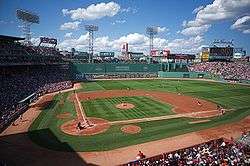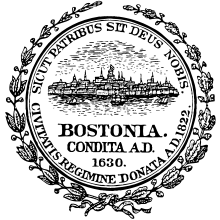Fenway Park
Fenway Park is a baseball park located in Boston, Massachusetts, near Kenmore Square. Since 1912, it has been the home for the Boston Red Sox, the city's American League baseball team, and since 1953, its only Major League Baseball (MLB) franchise. While the stadium was built in 1912, it was rebuilt in 1934.[9] It is the oldest active ballpark in MLB.[10] Because of its age and constrained location in Boston's dense Fenway–Kenmore neighborhood, the park has been renovated or expanded many times, resulting in quirky features including "The Triangle," Pesky's Pole, and the Green Monster in left field. It is the fifth-smallest among MLB ballparks by seating capacity, second-smallest by total capacity, and one of eight that cannot accommodate at least 40,000 spectators.
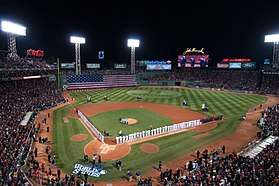 Fenway Park during the 2013 World Series pregame events | |
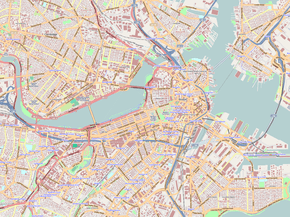 Fenway Park Location in Boston  Fenway Park Location in Massachusetts  Fenway Park Location in the United States | |
| Address | 4 Jersey Street[2] |
|---|---|
| Location | Boston, Massachusetts |
| Coordinates | 42°20′46.5″N 71°5′51.9″W |
| Public transit | at Lansdowne station at Kenmore station |
| Owner | Fenway Sports Group / Boston Red Sox |
| Operator | Fenway Sports Group / Boston Red Sox |
| Capacity | 37,305 (day) 37,755 (night)[3] |
| Record attendance | 47,627[4] |
| Field size | Left Field: 310 ft (94.5 m) Deep Left-Center: 379 ft (115.5 m) Center Field: 389 ft 9 in (118.8 m) Deep Right-Center: 420 ft (128 m) Right Center: 380 ft (115.8 m) Right Field: 302 ft (92 m) Backstop: 60 ft (18.3 m) 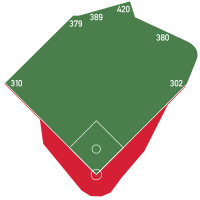 |
| Surface | Kentucky Blue Grass |
| Construction | |
| Broke ground | September 25, 1911 |
| Opened | April 20, 1912 (108 years ago) |
| Renovated | 1988, 2002–2011, 2017 |
| Expanded | 1934, 1946, 2002–2011, 2017 |
| Construction cost | US$650,000 ($17.2 million in 2019 dollars[5]) |
| Architect | James McLaughlin[6][7] |
| Structural engineer | Osborn Engineering Corp.[7] |
| General contractor | Charles Logue Building Company, Coleman Brothers, Inc.[7] |
| Tenants | |
| Boston Red Sox (MLB) (1912–present) Boston Braves (MLB) (1914–1915) Boston Bulldogs (AFL) (1926) Boston Redskins (NFL) (1933–1936) Boston Shamrocks (AFL) (1936–1937) Boston Yanks (NFL) (1944–1948) Boston Patriots (AFL) (1963–1968) Boston Beacons (NASL) (1968) Fenway Bowl (2020, planned debut) | |
Fenway Park | |
| NRHP reference No. | 12000069[8] |
| Added to NRHP | March 7, 2012 |
Fenway has hosted the World Series 11 times, with the Red Sox winning six of them and the Boston Braves winning one.[note 1] Besides baseball games it has been the site of many other sporting and cultural events including professional football games for the Boston Redskins, Boston Yanks, and the New England Patriots; concerts; soccer and hockey games (such as the 2010 NHL Winter Classic); and political and religious campaigns.
April 20, 2012, marked Fenway Park's centennial.[11] On March 7 of that year, the park was added to the National Register of Historic Places.[12] Former pitcher Bill Lee has called Fenway Park "a shrine".[13] It is a pending Boston Landmark which will regulate any further changes to the park. Today, the park is considered to be one of the most well-known sports venues in the world.[14]
History
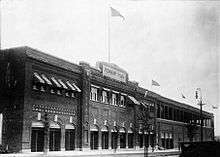
The Red Sox moved to Fenway Park from the old Huntington Avenue Grounds. In 1911, owner John I. Taylor purchased the land bordered by Brookline Avenue, Jersey Street, Van Ness Street and Lansdowne Street and developed it into a larger baseball stadium.[15]
Taylor claimed the name Fenway Park came from its location in the Fenway neighborhood of Boston, which was partially created late in the nineteenth century by filling in marshland or "fens",[15] to create the Back Bay Fens urban park. However, given that Taylor's family also owned the Fenway Realty Company, the promotional value of the naming at the time has been cited as well.[16] Like many classic ballparks, Fenway Park was constructed on an asymmetrical block, with consequent asymmetry in its field dimensions.[17] The park was designed by architect James E. McLaughlin, and the General Contractor was the Charles Logue Building Company.[18]
The first game was played April 20, 1912, with mayor John F. Fitzgerald throwing out the first pitch and Boston defeating the New York Highlanders, 7–6 in 11 innings. Newspaper coverage of the opening was overshadowed by continuing coverage of the Titanic sinking a few days earlier.[19]
In June 1919 a rally supporting Irish Independence turned out nearly 50,000 supporters to see the President of the Irish Republic, Éamon de Valera, and it was allegedly the largest crowd ever in the ballpark.[20]
.jpg)
Fenway Park had historically drawn low attendance, its lowest occurring late in the 1965 season with two games having paid attendance under 500 spectators.[22] Its attendance has risen since the Red Sox' 1967 "Impossible Dream" season, and on September 8, 2008, with a game versus the Tampa Bay Rays, Fenway Park broke the all-time Major League record for consecutive sellouts with 456, surpassing the record previously held by Jacobs Field in Cleveland.[23] On Wednesday, June 17, 2009, the park celebrated its 500th consecutive Red Sox sellout. According to WBZ-TV, the team joined three NBA teams which achieved 500 consecutive home sellouts.[24] The sellout streak ended on April 11, 2013; in all the Red Sox sold out 794 regular season games and an additional 26 postseason games during this streak.[25]
The park's address was originally 24 Jersey Street. In 1977, the section of Jersey Street nearest the park was renamed Yawkey Way in honor of longtime Red Sox owner Tom Yawkey, and the park's address was 4 Yawkey Way until 2018, when the street's name was reverted to Jersey Street. The address is now 4 Jersey Street.[2]

Changes to Fenway Park

Some of the changes include:[26]
- In 1934, a hand-operated scoreboard was added, with (what was then considered cutting-edge technology) lights to indicate balls and strikes.[27] The scoreboard is still updated by hand today from behind the wall. The National League scores were removed in 1976, but restored in 2003 and still require manual updates from on the field.[28]
- In 1946, upper deck seats were installed;[29] Fenway Park is essentially the first double-tiered ballpark in Boston since the South End Grounds of the 1880s.
- In 1947, arc lights were installed at Fenway Park.[29] The Boston Red Sox were the third-to-last team out of 16 major league teams to have lights in their home park.
- In 1976, metric distances were added to the conventionally stated distances because it was thought at the time that the United States would adopt the metric system. As of 2019, only Miami's Marlins Park and Toronto's Rogers Centre list metric distances. Fenway Park retained the metric measurements until mid-season 2002, when they were painted over.[30] Also, Fenway's first electronic message board was added over the center field bleachers.
- In 1988, a glass-protected seating area behind home plate named The 600 Club was built. After Ted Williams' death in 2002, it was renamed the .406 Club in honor of his 1941 season in which he produced a .406 batting average. The section was renamed again in 2006 to the EMC Club.[29]
- In 1999 the auxiliary press boxes were added on top of the roof boxes along the first and third base sides of the field.[31]
- In 2000, a new video display from Daktronics, measuring 23 feet (7.0 m) high by 30 feet (9.1 m) wide, was added in center field.
- Before the 2003 season, seats were added to the Green Monster.[32]
- Before the 2004 season, seats were added to the right field roof, above the grandstand, called the Budweiser Right Field Roof. In December 2017 Samuel Adams renamed the deck the "Sam Deck."[33]
- Before the 2008 season, the Coke bottles, installed in 1997, were removed to return the light towers to their original state.[34] The temporary luxury boxes installed for the 1999 All-Star Game were removed and permanent ones were added to the State Street Pavilion level. Seats were also added down the left field line called the Coca-Cola Party-Deck.[35]
- Before the 2011 season, three new scoreboards beyond right-center field were installed: a 38 ft × 100 ft (12 m × 30 m) scoreboard in right-center field, a 17 ft × 100 ft (5.2 m × 30.5 m) video screen in center field, a 16 ft × 30 ft (4.9 m × 9.1 m) video board in right field,[36] along with a new video control room. The Gate D concourse has undergone a complete remodel with new concession stands and improved pedestrian flow. The wooden grandstand seats were all removed to allow the completion of the waterproofing of the seating bowl and completely refurbished upon re-installation.
New Fenway Park
On May 15, 1999, then Red Sox CEO John Harrington announced plans for a new Fenway Park to be built near the existing structure.[37] It was to have seated 44,130 and would have been a modernized replica of the current Fenway Park, with the same field dimensions except for a shorter right field and reduced foul territory. Some sections of the existing ballpark were to be preserved (mainly the original Green Monster and the third base side of the park) as part of the overall new layout. Most of the current stadium was to be demolished to make room for new development, with one section remaining to house a baseball museum and public park.[38] The proposal was highly controversial; it projected that the park had less than 15 years of usable life, would require hundreds of millions of dollars of public investment, and was later revealed to be part of a scheme by current ownership to increase the marketable value of the team as they were ready to sell.[39] Several groups (such as "Save Fenway Park") formed in an attempt to block the move.[40] Discussion took place for several years regarding the new stadium proposal. One plan involved building a "Sports Megaplex" in South Boston, where a new Fenway would be located next to a new stadium for the New England Patriots. The Patriots ultimately built Gillette Stadium in Foxborough, their home throughout most of their history, which ended the Megaplex proposal. The Red Sox and the city of Boston failed to reach an agreement on building the new stadium, and in 2005, the Red Sox ownership group announced that the team would stay at Fenway Park indefinitely. The stadium has since been renovated, and will remain usable until as late as 2061.[41]
Seating capacity
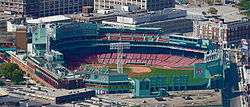
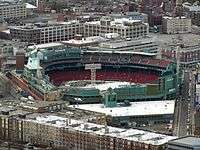
| Year(s) | Seating Capacity | Year(s) | Seating Capacity | ||
|---|---|---|---|---|---|
| Day | Night | Day | Night | ||
| 1912–1946 | 35,000 | 1992 | 33,925 | ||
| 1947–1948 | 35,500 | 1993–1994 | 34,218 | ||
| 1949–1952 | 35,200 | 1995–2000 | 33,455 | 33,871 | |
| 1953–1957 | 34,824 | 2001–2002 | 33,577 | 33,993 | |
| 1958–1959 | 34,819 | 2003 | 34,482 | 34,898 | |
| 1960 | 33,368 | 2004–2005 | 34,679 | 35,095 | |
| 1961–1964 | 33,357 | 2006 | 35,692 | 36,108 | |
| 1965–1967 | 33,524 | 2007 | 36,109 | 36,525 | |
| 1968–1970 | 33,375 | 2008[42] | 36,945 | 37,373 | |
| 1971–1975 | 33,379 | 2009[43] | 36,984 | 37,400 | |
| 1976 | 33,437 | 2010[44] | 36,986 | 37,402 | |
| 1977–1978 | 33,513 | 2011[45] | 37,065 | 37,493 | |
| 1979–1980 | 33,538 | 2012[46] | 37,067 | 37,495 | |
| 1981–1982 | 33,536 | 2013–2014[47] | 37,071 | 37,499 | |
| 1983–1984 | 33,465 | 2015[48] | 37,227 | 37,673 | |
| 1985–1988 | 33,583 | 2016[49] | 37,497 | 37,949 | |
| 1989–1990 | 34,182 | 2017[50] | 37,281 | 37,731 | |
| 1991 | 34,171 | 2018–present[3] | 37,305 | 37,755 | |
| Unless noted otherwise, all capacity figures are from Green Cathedrals: The Ultimate Celebrations of All 273 Major League and Negro League Ballparks Past and Present by Philip Lowry[51] | |||||
Features
The park is located along Lansdowne Street and Jersey Street in the Kenmore Square area of Boston. The area includes many buildings of similar height and architecture and thus it blends in with its surroundings. When pitcher Roger Clemens arrived in Boston for the first time in 1984, he took a taxi from Logan Airport and was sure the driver had misunderstood his directions when he announced their arrival at the park. Clemens recalled telling the driver "No, Fenway Park, it's a baseball stadium ... this is a warehouse." Only when the driver told Clemens to look up and he saw the light towers did he realize he was in the right place.[52]

Fenway Park is one of the two remaining jewel box ballparks still in use in Major League Baseball (the other being Wrigley Field), and both have a significant number of obstructed view seats, due to pillars supporting the upper deck. These are sold as such, and are a reminder of the architectural limitations of older ballparks.[53]
George Will asserts in his book Men at Work that Fenway Park is a "hitters' ballpark", with its short right-field fence (302 feet), narrow foul ground (the smallest of any current major league park), and generally closer-than-normal outfield fences. By Rule 1.04, Note(a),[54] all parks built after 1958 have been required to have foul lines at least 325 feet (99 m) long and a center-field fence at least 400 feet (120 m) from home plate. Regarding the narrow foul territory, Will writes:
The narrow foul territory in Fenway Park probably adds 5 to 7 points onto batting averages. Since World War II, the Red Sox have had 18 batting champions (through 1989)... Five to 7 points are a lot, given that there may be only a 15- or 20-point spread between a good hitting team and a poor hitting team.[55]:p. 175
Will states that some observers might feel that these unique aspects of Fenway give the Red Sox an advantage over their opponents, given that the Red Sox hitters play 81 games at the home stadium while each opponent plays no more than nine games as visiting teams but Will does not share this view.[55]:p. 177
Fenway Park's bullpen wall is much lower than most other outfield walls; outfielders are known to end up flying over this wall when chasing balls hit that direction, such as with Torii Hunter when chasing a David Ortiz game-tying grand slam that direction in Game 2 of the 2013 ALCS.
The Green Monster
The Green Monster is the nickname of the 37.167 feet (11.329 m)[56] left field wall in the park. It is located 310 to 315 feet (94 to 96 m) from home plate; this short distance often benefits right-handed hitters.[57]
Part of the original ballpark construction of 1912, the wall is made of wood, but was covered in tin and concrete in 1934 when the scoreboard was added. The wall was covered in hard plastic in 1976. The scoreboard is manually updated throughout the game. Despite the name, the Green Monster was not painted green until 1947; before that it was covered with advertisements. The Monster designation is relatively new; for most of its history it was simply called "the wall."[58] In 2003, terrace-style seating was added on top of the wall.[32]
"The Triangle"
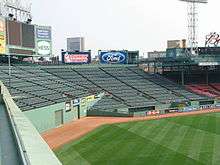

"The Triangle" is a region of center field where the walls form a triangle whose far corner is 420 feet (130 m) from home plate. That deep right-center point is conventionally given as the center field distance. The true center is unmarked, 390 feet (120 m) from home plate, to the left of "The Triangle" when viewed from home plate.[59]
There was once a smaller "triangle" at the left end of the bleachers in center field, posted as 388 feet (118 m). The end of the bleachers form a right angle with the Green Monster and the flagpole stands within that little triangle. That is not the true power alley, but deep left-center. The true power alley distance is not posted. The foul line intersects with the Green Monster at nearly a right angle, so the power alley could be estimated at 336 feet (102 m), assuming the power alley is 22.5° away from the foul line as measured from home plate.[60]
"Williamsburg"
"Williamsburg" was the name, invented by sportswriters, for the bullpen area built in front of the right-center field bleachers in 1940. It was built there primarily for the benefit of Ted Williams, to enable him and other left-handed batters to hit more home runs, since it was 23 feet (7.0 m) closer than the bleacher wall.[61]
The Lone Red Seat
The lone red seat in the right field bleachers (Section 42, Row 37, Seat 21) signifies the longest home run ever hit at Fenway. The home run, hit by Ted Williams on June 9, 1946,[62] was officially measured at 502 feet (153 m) – well beyond "Williamsburg". According to Hit Tracker Online, the ball, if unobstructed, would have flown 520 to 535 feet (158 to 163 m).[63]
The ball landed on Joseph A. Boucher, penetrating his large straw hat and hitting him in the head. A confounded Boucher was later quoted as saying,
How far away must one sit to be safe in this park? I didn't even get the ball. They say it bounced a dozen rows higher, but after it hit my head, I was no longer interested. I couldn't see the ball. Nobody could. The sun was right in our eyes. All we could do was duck. I'm glad I did not stand up.[64]
There have been other home runs hit at Fenway that have contended for the distance title. In the 2007 book The Year Babe Ruth Hit 104 Home Runs, researcher Bill Jenkinson found evidence that on May 25, 1926, Babe Ruth hit one in the pre-1934 bleacher configuration which landed five rows from the top in right field. This would have placed it at an estimated 545 feet (166 m) from home plate.[65] On June 23, 2001, Manny Ramirez hit one that struck a light tower above the Green Monster, which would have cleared the park had it missed. The park's official estimate placed the home run one foot short of Williams' record at 501 feet (152.7 m).[66] An April 2019 home run by Rowdy Tellez of the Toronto Blue Jays was initially reported as 505 feet (154 m), but later found to be significantly shorter, approximately 433 feet (132 m).[67]
Foul poles

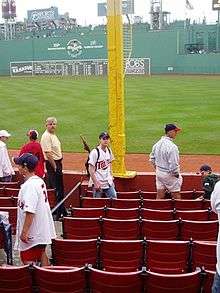

Pesky's Pole is the name for the pole on the right field foul line, which stands 302 feet (92 m) from home plate,[59] the shortest outfield distance (left or right field) in Major League Baseball.[68] Like the measurement of the left-field line at Fenway Park, this has been disputed. Aerial shots show it to be noticeably shorter[69] than the (actual) 302 foot line in right field, and Pesky has been quoted as estimating it to be "around 295 feet".
Despite the short wall, home runs in this area are relatively rare, as the fence curves away from the foul pole sharply. The pole was named after Johnny Pesky, a light-hitting shortstop and long-time coach for the Red Sox, who hit some of his six home runs at Fenway Park around the pole but never off the pole. Pesky (playing 1942 to 1952, except for 1943 to 1945) was a contact hitter who hit just 17 home runs in his career (6 at Fenway Park).[70] It's not known how many of these six actually landed near the pole. The Red Sox gives credit to pitcher and Sox broadcaster Mel Parnell for coining the name. The most notable for Pesky is a two-run homer in the eighth inning of the 1946 Opening Day game to win the game. According to Pesky, Mel Parnell named the pole after Pesky won a game for Parnell in 1948 with a home run down the short right field line, just around the pole. However, Pesky hit just one home run in a game pitched by Parnell, a two-run shot in the first inning of a game against Detroit played on June 11, 1950. The game was eventually won by the visiting Tigers in the 14th inning on a three-run shot by Tigers right fielder Vic Wertz and Parnell earned a no-decision that day.[71]
The term, though it had been in use since the 1950s, became far more common when Parnell became a Red Sox broadcaster in 1965. Mark Bellhorn hit what proved to be the game-winning home run off of Julián Tavárez, in Game 1 of the 2004 World Series off that pole's screen.
On September 27, 2006, on Pesky's 87th birthday, the Red Sox organization officially dedicated the right field foul pole as Pesky's Pole with a commemorative plaque placed at its base.[72]
The seat directly on the foul side of Pesky's Pole in the front row is Section 94, Row E, Seat 5 and is usually sold as a lone ticket.
In a ceremony before the Red Sox's 2005 game against the Cincinnati Reds, the pole on the left field foul line atop the Green Monster was named the Fisk Foul Pole, or Pudge's Pole, in honor of Carlton Fisk.[73] Fisk provided one of baseball's most enduring moments in Game 6 of the 1975 World Series against the Reds. Facing Reds right-hander Pat Darcy in the 12th inning with the score tied at 6, Fisk hit a long fly ball down the left field line. It appeared to be heading foul, but Fisk, after initially appearing unsure of whether or not to continue running to first base, famously jumped and waved his arms to the right as if to somehow direct the ball fair. It ricocheted off the foul pole, winning the game for the Red Sox and sending the series to a seventh and deciding game the next night, which Cincinnati won. Like Johnny Pesky's No. 6, Carlton had his No. 27 player number retired by the team.
"Duffy's Cliff"

From 1912 to 1933, there was a 10-foot (3.0 m) high incline in front of the then 25-foot (7.6 m)-high left field wall at Fenway Park, extending from the left-field foul pole to the center field flag pole. As a result, a left fielder had to play part of the territory running uphill (and back down). Boston's first star left fielder, Duffy Lewis, mastered the skill so well that the area became known as "Duffy's Cliff".[15]
The incline served two purposes: it was a support for a high wall and it was built to compensate for the difference in grades between the field and Lansdowne Street on the other side of that wall. The wall also served as a spectator-friendly seating area during the dead ball era when overflow crowds, in front of the later Green Monster, would sit on the incline behind ropes.[74]
As part of the 1934 remodeling of the ballpark, the bleachers, and the wall itself, Red Sox owner Tom Yawkey arranged to flatten the ground along the base of the wall, so that Duffy's Cliff no longer existed. The base of the left field wall is several feet below the grade level of Lansdowne Street, accounting for the occasional rat that might spook the scoreboard operators.[75]
There has been debate as to the true left field distance, which was once posted as 315 feet (96 m). A reporter from The Boston Globe was able to sneak into Fenway Park and measure the distance. When the paper's evidence was presented to the club in 1995, the distance was remeasured by the Red Sox and restated at 310 feet (94 m).[76] The companion 96-metre (315 ft) sign remained unchanged until 1998, when it was corrected to 94.5 metres (310 ft).[77]
Dell EMC Club
In 1983, private suites were added to the roof behind home plate. In 1988, 610 stadium club seats enclosed in glass and named the "600 Club", were added above the home plate grandstand replacing the existing press box. The press box was then added to the top of the 600 Club.[78] The 1988 addition has been thought to have changed the air currents in the park to the detriment of hitters.[79] In 2002, the organization renamed the club seats the ".406 Club" (in honor of Ted Williams' batting average in 1941).[79]
Between the 2005 and 2006 seasons the existing .406 club was rebuilt as part of the continuing ballpark expansion efforts. The second deck now features two open-air levels: the bottom level is the new "Dell EMC Club" featuring 406 seats and concierge services and the upper level, the State Street Pavilion, has 374 seats and a dedicated standing room area. The added seats are wider than the previous seats.[79]
Program hawkers
In 1990, Mike Rutstein started handing out the first issue of Boston Baseball Magazine (originally called Baseball Underground) outside of the park.[80] He was frustrated with the quality of the program being sold inside the park, which also came out once every two months.[81] The program was sold for $1, half the cost of the programs inside the park. To sell the program, Rutstein's employees would stand outside the park wearing bright red shirts and greet fans by holding a program up and shouting "Program, Scorecard, One Dollar!".[82] By 1992, the Red Sox organization filed complaints with the city code enforcement arguing that the scorecard inside the magazine was not covered under the First Amendment protecting magazines and that Rutstein's employees were operating on the streets without a permit.[83] Despite a lot of attention in the news, Rutstein said the charges were not pursued and no further legal action was taken.[84] In 2012, one of Rutstein's long time employees Sly Egidio[84] quit Boston Baseball to start "The Yawkey Way Report" named after Yawkey Way. By that time, Boston Baseball was selling for $3 per program, $2 cheaper than the in-park programs selling for $5. The Yawkey Way Report cost $1 and Egidio stationed his hawkers close to Boston Baseball's hawkers, starting a "hawker war."[85] The Yawkey Way Report also came with baseball cards, ponchos and tote bags, which caused Rutstein to file his own complaints with Boston city code enforcement. Despite the rivalry, both programs continue to be hawked outside of Fenway Park and are often the first thing fans see when they approach the stadium on game-day.
Park usage
Baseball
The Red Sox's one-time cross-town rivals, the Boston Braves used Fenway Park for the 1914 World Series and the 1915 season until Braves Field was completed; ironically, the Red Sox would then use Braves Field – which had a much higher seating capacity – for their own World Series games in 1915 and 1916.[86]
Neil Diamond's "Sweet Caroline" has been played at Fenway Park since at least 1997,[87] and in the middle of the eighth inning at every game since 2002.[88] On opening night of the 2010 season at Fenway Park, the song was performed by Diamond himself.
Since 1990 (except in 2005 when, because of field work, it was held in a minor league ballpark, and 2020, as the tournament was cancelled due to the COVID-19 pandemic), Fenway Park has also hosted the final round of a Boston-area intercollegiate baseball tournament called the Baseball Beanpot, an equivalent to the more well-known hockey Beanpot tourney. The teams play the first rounds in minor league stadiums before moving on to Fenway for the final and a consolation game.[89] Boston College, Harvard University, Northeastern University, and the University of Massachusetts Amherst compete in the four-team tournament.[90]
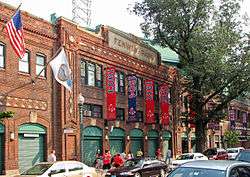
Beginning in 2006, the Red Sox have hosted the "Futures at Fenway" event, where two of their minor-league affiliates play a regular-season doubleheader as the "home" teams. Before the Futures day started, the most recent minor-league game held at Fenway had been the Eastern League All-Star Game in 1977.[91]
The 2009 Atlantic Coast Conference Baseball Tournament was scheduled to be held at Fenway Park, but a scheduling conflict caused the 2010 tournament to be scheduled at Fenway Park instead.[92] Due to economic reasons, the ACC elected to move the 2010 tournament from Fenway Park to NewBridge Bank Park in Greensboro, North Carolina, but is still looking to host a tournament at Fenway Park in the future.[93]
From 1970 to 1987, the Cape Cod Baseball League (CCBL) played its annual all-star game at various major league stadiums. The games were interleague contests between the CCBL and the Atlantic Collegiate Baseball League (ACBL). The 1975, 1977, 1979, 1981, 1983, 1985 and 1987 games were played at Fenway. The MVP of the 1977 contest was future major league slugger Steve Balboni, who clobbered two home runs over the Green Monster that day. The CCBL returned to Fenway in 2009, 2010 and 2011 for its intraleague all-star game matching the league's East and West divisions. The 2009 game starred East division MVP and future Boston Red Sox Chris Sale of Florida Gulf Coast University. The CCBL also holds an annual workout day at Fenway where CCBL players are evaluated by major league scouts.[94][95]
Boxing
On October 9, 1920, Fenway Park was the site of the first open-air boxing show in Boston. The card featured four bouts. Although Eddie Shevlin and Paul Doyle fought in the feature bout, Daniel J. Saunders of the Boston Daily Globe described heavyweights Battling McCreery and John Lester Johnson as "the only boxers who caused any excitement". McCreery, who according to Saunders, "was to take a flop in five rounds", won by judge's decision in ten rounds. After the fight, Johnson punched McCreery while McCreery was trying to shake his hand. McCreery then knocked Johnson out of the ring and hit him over the head with his chair. The card drew 5,000 spectators (half of what was expected) and brought in $6,100 (several thousand less than what was promised to the fighters).[96]
In 1928, New England Welterweight Champion Al Mello headlined three cards at Fenway. He defeated Billy Murphy in front of a crowd of 12,000 on June 26, Charlie Donovan on August 31, and Murphy again on September 13.[97][98][99]
On July 2, 1930, future World Heavyweight Champion James J. Braddock made his debut in that weight class. He defeated Joe Monte in ten rounds.[100]
On September 2, 1930, Babe Hunt defeated Ernie Schaaf in what The Boston Daily Globe described as a "dull bout" and a "big disappointment". The undercard included future light heavyweight champion George Nichols, who defeated Harry Allen of Brockton, Massachusetts in ten rounds.[101]
In 1932, Eddie Mack promoted ten cards at Fenway Park. The August 2 card featured World Light Heavyweight Champion Maxie Rosenbloom defeating Joe Barlow of Roxbury and Taunton' Henry Emond defeating The Cocoa Kid.[102] On August 23, Dave Shade defeated Norman Conrad of Wilton, New Hampshire in front of 3,500 attendees.[103] The September 6 card was headlined by World junior lightweight champion Kid Chocolate, who defeated Steve Smith.[104]
On June 25, 1936, former world heavyweight champion Jack Sharkey defeated Phil Brubaker in what would be his final career victory.[105]
In 1937, Rip Valenti and the Goodwin Athletic Club promoted five cards at Fenway. Three of these were headlined by New England Heavyweight Champion Al McCoy. On June 16 McCoy defeated Natie Brown in front of a crowd of 4,516.[106] On July 29 he knocked out Jack McCarthy in the third round.[107] On August 24 he and Tony Shucco fought to a draw.[108] Future WBA featherweight champion Sal Bartolo fought one of his first professional fights on the May 24 undercard.[109]
On June 25, 1945, Tami Mauriello knocked out Lou Nova in 2:47. An estimated crowd of 8,000 was in attendance.[110]
On July 12, 1954, Tony DeMarco knocked out George Araujo 58 seconds into the fifth round in front of 12,000 spectators.[111]
The most recent boxing event at Fenway took place on June 16, 1956. The undercard consisted of Eddie Andrews vs. George Chimenti, Bobby Courchesne vs. George Monroe for the New England Lightweight Championship, and Barry Allison vs. Don Williams for the New England Middleweight Championship. In the main event, Tony DeMarco defeated Vince Martinez by decision. An estimated 15,000 were in attendance - far below promoter Sam Silverman's expectations.[112]
Soccer
On October 17, 1925, the Boston Soccer Club and the Fall River Marksmen of the American Soccer League played a scoreless tie before 4,000 fans.[113] Boston also hosted the Providence Clamdiggers and Indiana Flooring at Fenway later that season.[114][115] On June 18, 1928, Boston played Rangers F.C. to a 2–2 tie in front of a crowd of 10,000.[116][117] In 1929, Boston hosted two more matches at Fenway Park; a 3–2 victory over the New Bedford Whalers on August 10 and a 3–2 loss to Fall River on August 17.[118][119]
On May 30, 1931; 8,000 fans were on hand to see the American Soccer League champion New York Yankees defeat Celtic 4–3.[120] The Yankees goalkeeper, Johnny Reder, would later return to play for the Boston Red Sox. During 1968, the park was home to the Boston Beacons of the now-defunct NASL.[121]
On July 21, 2010 Fenway hosted an exhibition game between European soccer clubs Celtic F.C. and Sporting C.P. in an event called "Football at Fenway". A crowd of 32,162 watched the two teams play to a 1–1 draw. Celtic won 6–5 on penalty shoot out, winning the first Fenway football challenge Trophy.[121] Recent matches have taken place between Liverpool, an English Premier League club owned by Fenway Sports Group, and A.S. Roma, an Italian Serie A club owned by FSG partner Thomas R. DiBenedetto. The July 25, 2012 match ended in a 2–1 win for AS Roma before a crowd of 37,169.[122] AS Roma also won the rematch on July 23, 2014 by a score of 1–0.[123] On July 21, 2019 Liverpool returned to Fenway for a preseason match against Sevilla, the Spanish team won 2–1 at the end of full-time.
Football
.jpg)
Football has been played at Fenway since at least 1916;[124] In 1926, the first American Football League's Boston Bulldogs played at both Fenway and Braves Field; the Boston Shamrocks of the second AFL did the same in 1936 and 1937. The National Football League's Boston Redskins played at Fenway for four seasons (1933–1936) after playing their inaugural season in 1932 at Braves Field as the Boston Braves. The Boston Yanks played there in the 1940s; and the American Football League's Boston Patriots called Fenway Park home from 1963 to 1968 after moving there from Nickerson Field. At various times in the past, Dartmouth College, Boston College, Brown University, and Boston University teams have also played football games at Fenway Park.[125] Boston College and Notre Dame played a game at Fenway in 2015 as part of Notre Dame's Shamrock Series.[126] The annual Harvard Yale game in November 2018 was played at Fenway.[127] Beginning in 2020, a new bowl game at Fenway called the Fenway Bowl will pit a team from the Atlantic Coast Conference against a team from the American Athletic Conference.[128]
Team records at Fenway
| Team | No. of Games | Record (W-L-T) |
|---|---|---|
| Boston College Eagles | 78 | 57–17–5 |
Hockey

The third annual NHL Winter Classic was held at Fenway on New Year's Day in 2010.[129] The Boston Bruins beat the Philadelphia Flyers 2–1 in sudden-death overtime, securing the first home-team victory in the relatively short history of the NHL Winter Classic. The Winter Classic paved the way for the Frozen Fenway series of ice skating and hockey events at the ballpark. Frozen Fenway is an annual series of collegiate and amateur games featuring ice hockey teams from local and regional high schools, colleges, and universities, including the University of Connecticut, University of Massachusetts Amherst, University of New Hampshire, University of Maine, University of Vermont, University of Massachusetts Lowell, Northeastern University, Boston College, and Boston University, and is held during the first part of the event. After the completion of the hockey series, the rink was opened to the public for free ice skating.[130]
Hurling and Gaelic Football
Fenway has hosted Gaelic games over the years. On June 6, 1937, the All-Ireland Football Champions from County Mayo defeated a Massachusetts team, 17–8,[131][132] and on November 8, 1954, the All-Ireland Hurling champions County Cork beat an American line-up, 37–28.[133] In more recent times, the Fenway Hurling Classic for the Players Champions Cup has been staged, first in November 2015 when Galway beat Dublin,[134] and subsequently in November 2017[135] and November 2018.[136]
Concerts

Fenway has been home to several concerts beginning in 1973 when Stevie Wonder and Ray Charles first played there.[137] No further concerts were played there until 2003 when Bruce Springsteen and the E Street Band played a leg of their The Rising Tour.[138] Since 2003, there has been at least one concert every year at Fenway by such artists as Bruce Springsteen and the E Street Band, Jimmy Buffett, Billy Joel, The Rolling Stones, Neil Diamond, The Police, Jason Aldean, Dave Matthews Band, Tom Petty & The Heartbreakers, Aerosmith, Phish, Roger Waters, Paul McCartney, James Taylor, Pearl Jam, Foo Fighters, and Dead & Company. In 2017, Lady Gaga brought her Joanne World Tour to the stadium,[139] making her the first woman to headline a concert there. In 2019, The Who played their first ever show at the stadium with the Boston Symphony Orchestra.[140]
Ski and snowboard

Polartec Big Air At Fenway is the first big air snowboarding and skiing competition that was held on February 11–12, 2016. This event was part of the U.S. Grand Prix Tour and the International Ski Federation's World Tour. Notable winter athletes that competed are Ty Walker, Sage Kotsenburg, and Joss Christensen. The big air jump was constructed to be about 140 feet (43 m) tall, standing above the lights of the stadium.[141]
Public address announcers
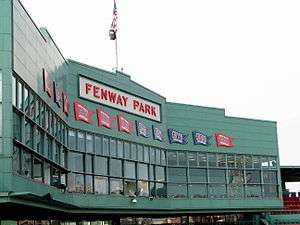
Frank Fallon was the first public address (PA) announcer for the Red Sox, and held the job from 1953 to 1957. Fred Cusick, better known for his career of announcing Boston Bruins hockey games, joined him in 1956 and also left after 1957.[142] Jay McMaster took over in 1958, until his replacement by Sherm Feller in 1967.[143] Feller served as the announcer for 26 years until his death after the 1993 season.[144] He was known for beginning his games by welcoming the fans with "Good afternoon, ladies and gentlemen, boys and girls. Welcome to Fenway Park", and ending them by saying "Thank you."[145] Leslie Sterling took the job for the 1994 season, becoming the second female PA announcer in the history of Major League Baseball.[142] Ed Brickley took over in 1997, and was replaced by Carl Beane in 2003.[142][143] Beane was regarded as an "iconic" announcer, and served until his death in 2012, which was caused by a heart attack suffered while driving.[145][146] Fenway used a series of guest announcers to finish the 2012 season[note 2] before hiring its current announcers: Henry Mahegan, Bob Lobel, and Dick Flavin.[148]
Retired numbers
There are eleven retired numbers above the right field grandstand. All of the numbers retired by the Red Sox are red on a white circle. Jackie Robinson's 42, which was retired by Major League Baseball, is blue on a white circle. The two are further delineated through the font difference; Boston numbers are in the same style as the Red Sox jerseys, while Robinson's number is in the more traditional "block" numbering found on the Dodgers jerseys.
Until the late 1990s, the numbers originally hung on the right-field facade in the order in which they were retired: 9-4-1-8. It was pointed out that the numbers, when read as a date (9/4/18), marked the eve of the first game of the 1918 World Series, the last championship that the Red Sox won before 2004. After the facade was repainted, the numbers were rearranged in numerical order.[149] The numbers remained in numerical order until the 2012 season, when the numbers were rearranged back into the order in which they were retired by the Red Sox.

The Red Sox policy on retiring uniform numbers was once one of the most stringent in baseball—the player had to be elected to the National Baseball Hall of Fame, play at least 10 years with the team, and retire as a member of the Red Sox. The final requirement was waived for Carlton Fisk as he had finished his playing career with the Chicago White Sox. However, Fisk was assigned a Red Sox front office job and effectively "finished" his baseball career with the Red Sox in this manner.[150] In 2008, the ownership relaxed the requirements further with the retirement of Johnny Pesky's number 6. Pesky has not been inducted into the Hall of Fame, but in light of his over 50 years of service to the club, the management made an exception. Pesky would have had 10 seasons, but he was credited with the three seasons he served as an Operations Officer in the U.S. Navy during World War II.[151] The most recent number retired was 34, worn by 2013 World Series Most Valuable Player David "Big Papi" Ortiz.
| Red Sox retired numbers[152] | |||||
| No. | Player | Position | Red Sox Years | Date Retired | Notes |
|---|---|---|---|---|---|
| 1 | Bobby Doerr | 2B | 1937–44 1946–51 |
May 21, 1988 | US Army, 1945 |
| 4 | Joe Cronin | SS | 1935–45 | May 29, 1984 | Player-Manager |
| 6 | Johnny Pesky | SS, 3B, 2B | 1942, 46–52 | September 28, 2008 | US Navy, 1943–45 |
| 8 | Carl Yastrzemski | LF, 1B, DH | 1961–83 | August 6, 1989 | |
| 9 | Ted Williams | LF | 1939–42 1946–60 |
May 29, 1984 | US Marines, 1943–45, 52–53 |
| 14 | Jim Rice | LF, DH | 1974–89 | July 28, 2009 | |
| 26 | Wade Boggs | 3B | 1983–1992 | May 26, 2016 | |
| 27 | Carlton Fisk | C | 1969, 71–80 | September 4, 2000 | |
| 34 | David Ortiz | DH | 2003–2016 | June 23, 2017 | 3× World Series Champion (2004, 2007, 2013) 2004 ALCS MVP, 2013 World Series MVP |
| 45 | Pedro Martínez | P | 1998–2004 | July 28, 2015 | World Series Champion 2004 |
| 42 | Jackie Robinson | Brooklyn Dodgers 1947–1956, retired by Major League Baseball, April 15, 1997 | |||
Ground rules
- A ball going through the scoreboard, either on the bounce or fly, is a ground rule double.
- A fly ball striking left-center field wall to right of or on the line behind the flag pole is a home run.
- A fly ball striking wall or flag pole and bouncing into bleachers is a home run.
- A fly ball striking line or right of same on wall in center is a home run.
- A fly ball striking wall left of line and bouncing into bullpen is a home run.
- A ball sticking in the bullpen screen or bouncing into the bullpen is a ground rule double.
- A batted or thrown ball remaining behind or under canvas or in tarp cylinder is a ground rule double.
- A ball striking the top of the scoreboard in left field in the ladder below top of wall and bouncing out of the park is a ground rule double.
- A fly ball that lands above the red line on top of the Green Monster and bounces onto the field of play is ruled a home run.[153]
- A fly ball that hits the rail in the right-center triangle is a home run.
It is a misconception among fans that a fly ball that gets stuck in the ladder above the scoreboard on the left field wall is ruled a ground rule triple. There is no mention of it in the Red Sox ground rules list.[153]
Access and transportation
- Fenway Park can be reached by the Massachusetts Bay Transportation Authority (MBTA) Green Line subway's Kenmore Station on the "B", "C" and "D" branches, as well as the Fenway Station on the "D" branch.[154]
- Lansdowne station is served by all MBTA Framingham/Worcester Line commuter rail trains.[155] This line provides service from South Station or Back Bay and points west of Boston. In 2014, the new station was completed with full-length platforms, elevators, and access to Brookline Avenue and Beacon Street.[156]
- Another option is taking the Orange Line or commuter rail to Back Bay or Ruggles. The stations are a 30-minute walk to Fenway.
- Although the Massachusetts Turnpike passes close to Fenway Park, there is no direct connection. Motorists are directed to use local streets or Storrow Drive to access the park.[157]
See also
- List of Major League Baseball stadiums
- National Register of Historic Places listings in southern Boston, Massachusetts
- Cask'n Flagon
Notes
- 1912 (defeated the New York Giants), 1914 (Braves defeated the Philadelphia Athletics), 1918 (defeated the Chicago Cubs), 1946 (lost to the St. Louis Cardinals), 1967 (lost to the St. Louis Cardinals), 1975 (lost to the Cincinnati Reds), 1986 (lost to the New York Mets), 2004 (defeated the St. Louis Cardinals), 2007 (defeated the Colorado Rockies), 2013 (defeated the St. Louis Cardinals) and 2018 (defeated the Los Angeles Dodgers). The first, in the park's inaugural season, was in 1912 and the most recent is in 2018.
- Guest announcers included Henry Mahegan, Jim Martin, Brian Maurer, James Demler, Jim Murray, Billy Lanni, Dick Flavin, Jon Meterparel, Mike Riley, Tom Grilk, David Wade, Kelly Malone, Dean Rogers, John Dolan, Jonathan Hardacker, David Cook, Charlie Bame-Aldred, Matt Goldstein, Travis Jenkins, Bob Lobel, Gordon Edes, Peter King, Eddie Palladino, and Andy Jick.[147]
References
- "Fenway Park Tour Information". Major League Baseball Advanced Media. Retrieved November 19, 2014.
- "So long Yawkey Way! Boston officially changes name of street outside Fenway Park". WCVB-TV. May 3, 2018. Retrieved May 3, 2018.
- "2018 Boston Red Sox Media Guide" (PDF). Major League Baseball Advanced Media. February 26, 2018. p. 11. Archived from the original (PDF) on April 8, 2018. Retrieved February 27, 2018.
- Moore, Gerry (September 23, 1935). "Record crowd near 49,000 jams Fenway Park". Boston Globe. Retrieved October 24, 2018.
- Federal Reserve Bank of Minneapolis. "Consumer Price Index (estimate) 1800–". Retrieved January 1, 2020.
- Turner, Greg (March 7, 2012). "Fenway Park Hits National Register of Historic Places". Boston Herald. Retrieved March 8, 2012.
- "Fenway Park". Baseball Almanac. Retrieved March 8, 2012.
- "Weekly List of Actions Taken on Properties:IES: 3/05/12 through 3/09/12". National Park Service. March 16, 2012. Retrieved May 5, 2012.
- https://www.mlb.com/redsox/ballpark/facts-figures
- J.M. Soden (July 19, 2011). "Major League Baseball's five oldest ballparks". Yahoo! Sports. Archived from the original on April 24, 2013. Retrieved December 8, 2013.
- Swasey, Benjamin (April 20, 2012). "Red Sox, City Celebrate Fenway's 100th". WBUR. Retrieved November 22, 2014.
- Reidy, Chris (March 7, 2012). "Fenway Park Is Listed in the National Register Of Historic Places". The Boston Globe. Retrieved March 8, 2013.
- "Writers Speaking About the Books They Write". The Great Fenway Park Writers Series. 2012. Archived from the original on December 10, 2007. Retrieved April 20, 2012.
- "When Baseball Meets Football: Boston and Liverpool". BBC. October 6, 2010. Retrieved October 9, 2010.
- Foulds, Alan E. (2005). Boston's Ballparks & Arenas. UPNE. p. 48. ISBN 1-58465-409-0.
- Nash, Peter J. (2005). Boston's Royal Rooters. Arcadia Publishing. p. 45. ISBN 0-7385-3821-3.
- "Friday Fantasies (Fantastic Fenway Edition)". The Second Empire. April 20, 2012. Retrieved April 20, 2012.
- Stout, Glenn (October 11, 2011). Fenway 1912: The Birth of a Ballpark, a Championship Season, and Fenway's Remarkable First Year. Houghton Mifflin Harcourt.
- "National Geographic Special: Inside Fenway Park: An Icon at 100". PBS. March 2012. Retrieved March 28, 2012.
- Tom (2015-03-04). "Fenway Park Rally Supporting Irish Independence". Cool Old Photos. Retrieved 2019-02-23.
- Tom (2015-03-04). "Fenway Park Rally Supporting Irish Independence". Cool Old Photos. Retrieved 2019-02-23.
- "1965 Boston Red Sox Schedule, Box Scores and Splits". Baseball-Reference. Archived from the original on July 9, 2008. Retrieved March 8, 2013.
- Ulman, Howard (September 8, 2008). "Fenway Sells Out for Record 456th Straight Time". USA Today. Retrieved September 8, 2008.
- Silverman, Michael (June 18, 2009). "Fenway Sellout Streak Hits 500". Boston Herald. Retrieved June 21, 2009.
- Cafardo, Nick (April 11, 2013). "As Red Sox' Attendance Streak Ends, What's Next?". The Boston Globe. Retrieved April 11, 2013.
- "Fenway Park". BallparkTour. Archived from the original on September 23, 2015. Retrieved June 3, 2014.
- Cornette, Kristen D. (2008). "What Makes Fenway Fenway?". RedSoxDiehard. Retrieved March 8, 2013.
- Scottberg, Erin (October 1, 2009). "Scoreboard Operator: This Is My Job". Popular Mechanics. Archived from the original on June 4, 2009. Retrieved October 1, 2009.
- "100 Fenway Park Facts: 1-51". CBS Boston. WBZ-TV. April 19, 2012. Retrieved November 25, 2014.
- Powers, John; Driscoll, Ron (2012). Fenway Park: A Salute to the Coolest, Cruelest, Longest-running Major League Ballpark in America. Running Press. p. 139. ISBN 9780762442041.
fenway metric 1976.
- "1999". Boston Red Sox. Retrieved November 25, 2014.
- "Fenway Park Adds Green Monster Seats, Red Sox' Revamped Offense Leads Boston to ALCS in 2003". New England Sports Network. August 27, 2011. Retrieved November 25, 2014.
- "2004". Boston Red Sox. Retrieved November 25, 2014.
- Lamothe, Dan (March 3, 2008). "Coke overdose? Maybe, but say goodbye to those bottles". Mass Live. Retrieved November 25, 2014.
- "2008". Boston Red Sox. Retrieved November 25, 2014.
- Stack, Kyle (March 31, 2011). "Field of Dreams: Ballparks Unveil Tech Upgrades". Wired.
- "New Fenway Park". Ballparks.com. Retrieved March 8, 2013.
- Smith, Curt (2001). Storied Stadiums. New York City: Carroll & Graf. ISBN 0-7867-1187-6.
- "He Saved Fenway Park - Sports Media Guide". 2 February 2015. Archived from the original on 2015-02-02.
- "Save Fenway Park!". Save Fenway Park. 2004. Archived from the original on September 15, 2000. Retrieved April 20, 2012.
- Abraham, Peter (February 19, 2011). "Lucchino: Fenway Will Stand for Decades". The Boston Globe. Retrieved February 20, 2011.
- Araton, Harvey (April 26, 2009). "Red Sox Preserving Fenway's Winning Appeal". The New York Times. Retrieved September 24, 2011.
- "Fenway Park". Seamheads. Retrieved September 21, 2011.
- "Rays 6, Red Sox 5". The Daily Gazette. Schenectady, New York. April 19, 2010. Retrieved September 24, 2011.
- Livingstone, Seth (April 20, 2011). "99 and Counting: Fenway Park in Its Centennial Season". USA Today. Retrieved March 25, 2015.
- Schworm, Peter (April 13, 2012). "As Red Sox Sputter Early, Sellout Streak in Jeopardy". The Boston Globe. Retrieved May 30, 2012.
- Brown, Maury (March 4, 2013). "2013 American League Attendance Projections". Baseball Prospectus. Retrieved March 8, 2013.
- "2015 Boston Red Sox Media Guide" (PDF). Major League Baseball Advanced Media. March 12, 2015. p. 11. Retrieved March 25, 2015.
- "2016 Boston Red Sox Media Guide" (PDF). Major League Baseball Advanced Media. February 16, 2016. p. 11. Retrieved February 18, 2017.
- "2017 Boston Red Sox Media Guide" (PDF). Major League Baseball Advanced Media. February 21, 2017. Archived from the original (PDF) on February 23, 2017. Retrieved February 22, 2017.
- Lowry, Philip (2006). Green Cathedrals: The Ultimate Celebrationsof All 273 Major League and Negro League Ballparks Past and Present. New York City: Addison Wesley Publishing Company. ISBN 0-201-62229-7.
- Nowlin, Bill; Prime, Jim (2005). Blood Feud: The Red Sox, the Yankees and the Struggle of Good Vs. Evil. Rounder Records. ISBN 978-1-57940-111-5.
- Grossfeld, Stan (June 17, 2005). "The Worst Seats at Fenway". The Boston Globe. Retrieved June 17, 2005.
- "Official Rules". Major League Baseball Advanced Media. 2012. Retrieved April 20, 2012.
- Will, George (1990). Men at Work: The Craft of Baseball. MacMillan.
- Hoffarth, Tom (August 5, 2008). "A Southern California Guide to Fenway Park". Los Angeles Daily News. Archived from the original on October 21, 2008. Retrieved November 9, 2008.
- Paper, Lew (29 September 2009). Perfect: Don Larsen's Miraculous World Series Game and the Men Who Made it Happen. Penguin Publishing. ISBN 9781101140451. Retrieved December 3, 2014.
- "Fenway Park Timeline – 1947". Major League Baseball Advanced Media. Retrieved March 8, 2013.
- "Facts and Figures". Boston Red Sox. Retrieved December 4, 2014.
- Mann, Jack (June 28, 1965). "The Great Wall Of Boston". Sports Illustrated. Retrieved December 2, 2014.
- "Fenway Park Timeline – 1940". Major League Baseball Advanced Media. Retrieved March 8, 2013.
- Kaese, Harold (June 10, 1946). "Ted Williams blasts longest home run in Fenway Park". The Boston Globe. Retrieved April 20, 2019 – via bostonglobe.com.
- Rybarczyk, Greg (2009). "Highlight Home Runs". ESPN. Retrieved April 20, 2012.
- Shaughnessy, Dan (June 9, 1996), "Long Ago It Went Far Away", The Boston Globe, Boston, Massachusetts
- Jenkinson, William (2007). The Year Babe Ruth Hit 104 Home Runs. Carroll & Graf. ISBN 978-0-7867-1906-8.
- "Ramirez Hits Fenway's Second-Longest Homer". Sports Illustrated. Associated Press. June 23, 2001. Archived from the original on September 11, 2013. Retrieved April 20, 2012.
- Penney, Sean (April 12, 2019). "Red Sox: Nathan Eovaldi didn't give up the longest home run in Fenway Park history". bosoxinjection.com. Retrieved April 20, 2019.
- Spirito, Lou (March 27, 2014). "Baseball's Many Physical Dimensions" (Image). visual.ly. Retrieved December 3, 2014.
- Bucholtz, Andrew. "Yankees' shortstop Didi Gregorius hit a 295-foot home run, one of the shortest ever". Archived from the original on 2017-07-18. Retrieved 2018-10-24.
- Pesky at Baseball Reference
- "Pesky Pole at Fenway Park". redsoxconnection.com. Archived from the original on 2008-10-16. Retrieved 2009-08-31.
- Pesky Pole Ceremony (Streaming Video). Trueveo. September 27, 2006. Retrieved September 27, 2006.
- Petraglia, Mike (June 13, 2005). "Sox Honor Fisk with Left-Field Foul Pole". Major League Baseball Advanced Media. Retrieved May 11, 2012.
- Shaughnessy, Dan (October 25, 2005). "A Baseball Showcase in Football Land". The Boston Globe. Retrieved October 25, 2005.
- Nowlin, Bill; Tan, Cecilia (2004). The Fenway Project:June 28, 2002 : a Project of the Society for American Baseball Research and SABR Boston. Rounder Books. ISBN 978-1-57940-091-0.
- "Facts and Figures". Major League Baseball Advanced Media. Retrieved March 8, 2013.
- "Fenway Park". Sportsvenue.info. Archived from the original on June 2, 2013. Retrieved March 8, 2013.
- "Fenway Park Information – Milestones". Major League Baseball Advanced Media. 2012. Retrieved May 11, 2012.
- "Red Sox EMC Club Tickets". Fenway Ticket King. 2012. Retrieved May 11, 2012.
- "Archived copy". Archived from the original on 2019-02-12. Retrieved 2019-02-11.CS1 maint: archived copy as title (link)
- https://www.upi.com/Archives/1990/05/24/Underground-Red-Sox-program-finding-a-niche/8428643521600/
- Rutstein, Mike (2009). Outside Pitch: Twenty Years of Boston Baseball. ISBN 978-1449524791.
- https://www.newsweek.com/take-these-sox-and-shove-it-198040
- http://yawkeywayreport.com/meet-the-staff/ceo-sly-egidio/
- https://www.bostonglobe.com/metro/2014/09/10/fenway-scene-war-among-rival-hawkers-game-programs/eTsR16JIvyshTp3S7tLhEJ/story.html
- "Fenway Park Information – Facts and Figures". Major League Baseball Advanced Media. 2012. Retrieved May 11, 2012.
- Browne, Ian (April 17, 2013). "Fenway Park's anthem started innocuously". Major League Baseball Advanced Media. Retrieved April 20, 2016.
- Vosk, Stephanie (May 29, 2005). "Another mystery of the Diamond, explained at last". The Boston Globe.
- "Lowell Spinners hosts 2012 Baseball Beanpot". Boston Central. Retrieved May 5, 2012.
- "Boston College, Harvard Baseball Teams Square Off at Fenway Park for Baseball's Beanpot". NESN. April 29, 2011. Retrieved May 5, 2012.
- "Fenway Park to host Minor League doubleheader Aug. 26, 2006". Major League Baseball Advanced Media. December 15, 2005. Retrieved April 20, 2012.
- "ACC Tourney on Hold". Boston Herald. Associated Press. September 11, 2008. Retrieved April 20, 2012.
- "2010 ACC Baseball Championship moves to Greensboro, N.C.'s NewBridge Bank Park" (Press release). Atlantic Coast Conference. May 5, 2009. Archived from the original on September 27, 2011. Retrieved April 20, 2012.
- "Under Armour CCBL All-Star Game at Fenway Park". capecodbaseball.org. Retrieved August 16, 2019.
- "Cape Leaguers work out at Fenway Park". capecodbaseball.org. Retrieved August 16, 2019.
- Saunders, Daniel J. (October 10, 1920). "Fenway Park Fans See Mill Not on the Card". The Boston Daily Globe.
- Egan, David F. (June 27, 1928). "Mello Victor in Stirring 10 Rounds". The Boston Daily Globe.
- Egan, David F. (September 1, 1928). "Mello Scores Technical Knockout At Fenway Park". The Boston Daily Globe.
- Egan, David F. (September 14, 1928). "Mello Stops Murphy in the Fifth Round". The Boston Daily Globe.
- Egan, David F. (July 3, 1930). "Braddock Smashes His Way to Victory". The Boston Daily Globe.
- Egan, David F. (September 3, 1930). "Hunt Victor in Dull Bout". The Boston Daily Globe.
- Egan, David F. (August 3, 1932). "Barlow No Match For Rosenbloom". The Boston Daily Globe.
- Egan, David F. (August 24, 1932). "Shade Outsmarts Boy From Wilton, NH". The Boston Daily Globe.
- Egan, David F. (September 7, 1932). "Kid Chocolate an Easy Winner". The Boston Daily Globe.
- "Sharkey is Victor; Defeats Brubaker". The New York Times. June 26, 1936.
- Ralby, Herbert (June 17, 1937). "McCoy Goes 10 to Beat Brown". The Boston Daily Globe.
- Fitzgerald, Tom (July 30, 1937). "McCoy Stops His Foe Early". The Boston Daily Globe.
- Fitzgerald, Tom (August 25, 1937). "Shucco Gets Draw, Throng Goes Wild". The Boston Daily Globe.
- Fitzgerald, Tom (May 25, 1937). "Fuller Winner of Callahan". The Boston Daily Globe.
- "Mauriello Stops Nova in the 1st Round". The New York Times. June 26, 1945.
- "Tony DeMarco Stops Araujo in the Fifth". The New York Times. July 13, 1954.
- Ahern, John (June 17, 1956). "DeMarco's Wild Rally Beats Martinez in 10". The Boston Daily Globe.
- "Boston and Fall River Play to Scoreless Tie at Fenway Park". The Boston Daily Globe. October 18, 1925.
- "Boston Defeats Providence, 2-1". The Boston Daily Globe. November 1, 1925.
- "Indiana Flooring Eleven to Meet Woodsies Here Saturday". The Boston Daily Globe. November 4, 1925.
- Collins, George M. (June 19, 1928). "Loud in Praise of Hub Team". The Boston Daily Globe.
- "Unheralded Rivalry". Boston Herald. January 4, 2001.
- Collins, George M. (August 11, 1929). "Wonder Workers Trim the Whalers". The Boston Daily Globe.
- Collins, George M. (August 18, 1929). "Marksmen Carry Away Two Points". The Boston Daily Globe.
- Collins, George M. (May 31, 1931). "Yankees Pin Defeat on Glasgow Celtics". The Boston Daily Globe.
- Kennedy, Paul (July 22, 2010). "Soccer Goes Mainstream at Fenway". Soccer America. Retrieved October 14, 2011.
- "Roma Tops Liverpool at Fenway Park". ESPN Boston. July 26, 2012. Retrieved July 26, 2012.
- "AS Roma Beats Liverpool at Fenway". Boston Globe. July 24, 2014. Retrieved August 6, 2014.
- "Renewed Holy Cross-Boston College football rivalry kicks off Saturday". Worcester Telegram & Gazette. Retrieved September 6, 2018.
- "Dartmouth beats Brown in battle at Fenway Park - The Boston Globe". BostonGlobe.com. Archived from the original on 2017-12-13. Retrieved 2017-12-13.
- "Fenway Park to host BC-Notre Dame football in 2015". Comcast Sportsnet. December 20, 2013. Archived from the original on December 24, 2013. Retrieved December 22, 2013.
- Harvard Yale Game Will Be Played In Fenway in 2018 Retrieved March 20, 2018
- "New bowl game at Fenway Park to match teams from ACC, AAC". San Francisco Chronicle. September 16, 2019. Retrieved September 16, 2019.
- Rosen, Dan (July 15, 2009). "Flyers-Bruins to Hit the Ice at Boston's Fenway Park". National Hockey League. Retrieved July 17, 2009.
- "Public Skating at Fenway Park to Begin in Jan". WHDH. Boston. January 12, 2009. Archived from the original on January 17, 2012. Retrieved May 5, 2012.
- Jones, Victor O. (June 7, 1937). "Mayos Every Bit Champs". The Boston Globe. p. 24. Retrieved November 19, 2018 – via newspapers.com.
- "Mayo Wins in Boston". The Record. Hackensack, New Jersey. AP. June 7, 1937. p. 18. Retrieved November 19, 2018 – via newspapers.com.
- "Irish Hurling Team Shows Lethal Style in Boston". The Boston Globe. November 8, 1954. p. 15. Retrieved November 18, 2018 – via newspapers.com.
- "Exhibition match? Dublin and Galway take chunks out of each other in mass brawl". The 42. 23 November 2015. Retrieved 1 November 2017.
- "Clare beat Galway to Fenway Hurling Classic title in Boston". Irish Times. 20 November 2017. Retrieved 20 November 2017.
- "All-Ireland champions Limerick round off glorious year with Fenway Classic win". Irish Independent. 18 November 2018. Retrieved 20 November 2018.
- "Fenway rocks as concert venue". Boston Globe. Boston Globe Media Partners, LLC. Retrieved 18 December 2019.
- "Fenway Park Concert Tickets". Fenway Ticket King. Retrieved July 9, 2012.
- Johnston, Maura. "Lady Gaga makes a powerful statement at Fenway". Boston Globe. Boston Globe Media Partners, LLC. Retrieved 18 December 2019.
- Slane, Kevin. "The Who will play Fenway Park this summer". Boston Globe. Boston Globe Media Partners, LLC. Retrieved 18 December 2019.
- Treffeisen, Beth (January 21, 2016). "Fenway Park is morphing into a gigantic ski slope for February competition". NewBostonPost. Retrieved April 12, 2016.
- Cafardo, Nick (February 3, 2013). "Red Sox still searching for a new PA voice". The Boston Globe. Retrieved November 22, 2014.
- Ballou, Bill (May 11, 2012). "Red Sox Remember Carl Beane as 'Icon'". Telegram & Gazette. Worcester, Massachusetts. Retrieved May 20, 2012.
- Long, Tom (January 29, 1994). "Sherm Feller Was Fenway Park's Voice of the Boston Red Sox". The Boston Globe. p. 26.
- Frommer, Harvey (May 9, 2012). "Remembering Carl Beane: "The Voice" of the Boston Red Sox Will Be Missed". Bleacher Report. Retrieved November 22, 2014.
- "'Voice of Fenway' dies after heart attack behind wheel". WCBV. May 10, 2012. Retrieved November 22, 2014.
- Teitell, Beth (June 13, 2012). "Voices Line up for Red Sox Announcer Job". The Boston Globe. Retrieved June 16, 2012.
- Wilbur, Eric (May 31, 2012). "Red Sox Talent Show is All Wrong". The Boston Globe. Retrieved June 16, 2012.
- Silva, Steve (May 30, 2012). "Red Sox to Have Tryouts for New Fenway Park PA Announcer to Replace Carl Beane". The Boston Globe. Retrieved June 16, 2012.
- "WBZ TV's David Wade Gets a Turn as Red Sox PA Announcer Friday Night". WBZ. Boston. July 9, 2012. Retrieved July 9, 2012.
- Edes, Gordon. "Carl Beane Tough to Get Over". ESPNW. Retrieved July 9, 2012.
- Thomas, Kevin (June 17, 2012). "On Baseball: Baseball Binds Father, Son". Portland Press Herald. Retrieved July 9, 2012.
- "Red Sox tab three for Fenway PA duties". ESPN Boston. Retrieved April 12, 2013.
- Golen, Jimmy (April 21, 2011). "Boston Notes Fenway 100th; Yearlong Celebration Planned". Telegram & Gazette. Worcester, Massachusetts. Retrieved April 21, 2011.
- Neff, Andrew (June 30, 2005). "Sea Dogs Try to Get the Boot". Bangor Daily News. p. C5. Retrieved March 8, 2013.
- Vega, Michael (September 24, 2008). "Pesky Makes Honor Roll". The Boston Globe. Retrieved September 25, 2008.(Pay wall)
- "Retired Uniform Numbers in the American League". Baseball Almanac. Retrieved September 26, 2008.
- "Ballpark: Ground Rules". Major League Baseball Advanced Media. Retrieved March 8, 2013.
- "Directions to Fenway Park – Subway". Major League Baseball Advanced Media. Retrieved July 16, 2009.
- "MBTA Schedules and Maps – Commuter Rail – Yawkey". Massachusetts Bay Transportation Authority. Retrieved March 10, 2014.
- "MBTA Schedules and Maps – Commuter Rail – Framingham/Worcester". Massachusetts Bay Transportation Authority. Retrieved March 10, 2014.
- "Directions to Fenway Park – Automobile". Major League Baseball Advanced Media. Retrieved July 16, 2009.
External links
| Wikimedia Commons has media related to Fenway Park. |
- Stadium site on redsox.com
- Fenway Park Seating Chart at Precise Seating
- Fenway Park info, including information on visiting
- Fenway Park facts, photos, statistics and trivia
- Boston Ballpark History. MLB.com.
- Fenway Park dynamic diagram at Clem's Baseball
- Google Maps Aerial view
- VisitingFan.com: Reviews of Fenway Park
- Fenway Park Seating Chart
- Fenway Park 100th Anniversary page MLB.com
- Fenway Park at Stadium Journey
- Fenway Park at Sportlistings directory


